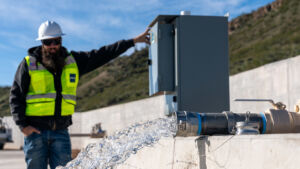|
Look at any image of the Earth taken from space and chances are you’ll find yourself marveling at what looks like the very essence of tranquility. But the serenity of our blue-swirled marble floating peacefully in the black void is deceiving. The reality is more like that of soccer ball kicked around in a hail storm. Earth, and all the other objects in the solar system, plow through what is known as the solar wind – a constant stream of high-energy particles, mostly protons and electrons, hurled into space by the thermonuclear furnace that is our sun. “If you take all the energy consumed in the U.S. in one year and multiply that by a million, you get the output of the sun in one second. All forms of energy, except for atomic energy, ultimately come from the sun,” says Joe Giacalone, a UA professor and astrophysicist who is excited about the upcoming launch of the first-ever mission to “touch the sun.” NASA’s Parker Solar Probe, encapsulated in the nose cone of a Delta IV Heavy rocket, is awaiting countdown to liftoff, which is currently scheduled for Aug. 11 at 3:33 a.m. from Kennedy Space Center in Florida. The mission was named after Eugene Parker, the solar astrophysicist who discovered the solar wind, and has been in the works for more than half a century. It was conceived before a space program, or even NASA, existed. “I was working at the Jet Propulsion Laboratory at the time – in 1956, pre-space age – to work on rockets and things like that,” says Marcia Neugebauer, a professor emerita of the UA’s Lunar and Planetary Lab. “Sputnik had just happened, and, shortly after, the Explorer program sent the first U.S. satellite into space, so we thought about how to design something to find out if Parker was right or not.” Parker’s theory on solar wind was highly debated at the time because no measurements of the actual phenomenon existed. But it proved correct. Now, 60 years later, a spacecraft is bring sent to “directly sample solar particles and magnetic fields in an attempt to resolve some of the most important questions facing the field of solar science today,” according to NASA. The nearest previous observations came from the Helios spacecraft, says Kristopher Klein, who joined the UA’s Lunar and Planetary Lab as an assistant professor last year and, like Giacalone, is a co-investigator on the Parker mission. The pair of probes launched in the 1970s have come as close as the orbit of Mercury, the solar system’s innermost planet. “But that doesn’t get you into the regions where the acceleration happens,” Klein says. “We have seen what is almost the fossilized remains of any activity happening there and had to piece it together by guess.” The Parker Solar Probe is the first attempt to get close to the sun and study the solar wind at its source, rather than in Earth’s orbit. Scientists are hoping to find answers to questions that seem fundamental in nature, yet have eluded them for decades. One of the most vexing problems the probe is sent to investigate is the dramatic jump in temperature the solar wind undergoes as it leaves the sun’s surface and enters its atmosphere, or corona. Across the mere relative thickness of an onion’s skin, some unknown mechanism heats the particles, also known as plasma, from about 9,000 degrees Fahrenheit at the surface to two million degrees or more in the corona. Giacalone hopes for answers to other questions, too. “Where does the solar wind come from? What causes flares and coronal mass ejections? We still don’t understand these processes,” he says. The Parker Solar Probe will make “humanity’s first visit to a star” as NASA puts it. During seven fly-bys, the spacecraft will approach the sun to within 10 solar radii, far enough to not burn up and close enough to dive into the corona. “We’ll get close enough to where most of the mechanisms that are pushing the particles out are still actively doing that pushing,” says Klein, and the results are expected to shed light on many fundamental physical processes. “It will provide us with a better understanding of the environment the Earth is in,” he says. “Our ability to forecast space weather is about as good as our weather forecasts were in the 1970s. If you have a better understanding of the behavior of these solar energetic particles, then you can make better predictions about when to send astronauts to Mars or protect a satellite before it gets ripped apart by a radiation burst.” Paying a close visit to the sun also provides an opportunity to learn about phenomena such as other stars, plasma accretion disks around black holes and the interstellar medium, a very low-density plasma that fills the galaxy. Sending the Parker Solar Probe to the sun might even help with developing plasma here on Earth – for example, developing fusion reactors that could someday provide sustainable energy. “The plasma inside these magnetic bottles behaves a lot like the solar wind,” Klein says, “Learning how we can control it in confinement is crucial.” |
Home / Business News / Aerospace / UA scientists gear up to ‘touch the sun’



